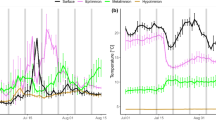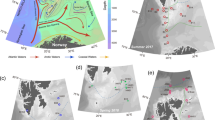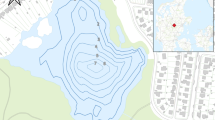Abstract
Zeekoevlei is the largest freshwater lake in South Africa and has a century-long history of anthropogenic impact that caused hyper-eutrophic conditions. We used biomarkers (alkanes and pigments), stable isotopes (δ13C and δ15N), rates of primary palaeoproduction and total inorganic carbon (TIC) accumulation rates in the lake sediments to investigate changes in plankton and macrophyte communities in response to anthropogenic activities in this shallow lake. Specific alkanes (ΣC15,17,19, pristane, phytane and n-C29/n-C17 ratio) and pigment (chlorophyll a, β,β-carotene, echinenone, fucoxanthin and zeaxanthin) concentrations in lake waters indicated the present-day hyper-eutrophic condition and seasonal fluctuations of cyanobacteria, zooplankton and diatom populations. Eutrophic conditions were initiated in the lake with the start of recreational activities and construction of a sewage treatment plant in the early 1920s. The lake transformed from a eutrophic to a hyper-eutrophic waterbody following damming, pondweed eradication and accelerated catchment-derived nutrient input. The change in lake trophic state was recorded by a sharp decline in the terrestrial to aquatic ratio (TAR) of specific n-alkanes, low carbon preference index (CPI) and increased δ13C values in the sediment core. In addition, the aquatic macrophyte n-alkane proxy (Paq) values (~1) indicated a slow takeover by floating macrophytes after the eradication of submerged pondweeds in 1951. Elevated n-alkane (ΣC15,17,19), total alkane and pigment (chlorophyll a, β,β-carotene, zeaxanthin and zeaxanthin to β,β-carotene ratio) concentrations, low δ15N values and low TIC accumulation rates in the upper middle section of the core indicated the beginning of intense cyanobacterial blooms after the dredging in 1983. Although the cyanobacterial population has decreased in recent years, hyper-eutrophic conditions are reflected by low CPI <0.04 and TAR <1 values at the top of the sediment core.



Similar content being viewed by others
References
Alexander R, Kagi R, Woodhouse GW (1981) Geochemical correlation of Windalia oil and extracts of winning group (Cretaceous) potential source rocks, Barrow Subbasin, Western Australia. Am Assoc Pet Geol Bull 65:235–250
Allan J, Douglas AG (1977) Variations in the content and distribution of n-alkanes in a series of carboniferous vitrinites and sporinites of bituminous rank. Geochim Cosmochim Acta 41:1223–1230. doi:10.1016/0016-7037(77)90068-0
Bianchi TS (2007) Biogeochemistry of Estuaries. Oxford University Press, New York, 799 pp
Bianchi TS, Findlay S (1991) Decomposition of Hudson Estuary macrophytes: photosynthetic pigment transformations and decay constants. Estuaries 14:65–73. doi:10.2307/1351983
Bianchi TS, Rolff C, Lambert CD (1997) Sources and composition of particulate organic carbon in the Baltic Sea: the use of plant pigments and lignin-phenols as biomarkers. Mar Ecol Prog Ser 156:25–31. doi:10.3354/meps156025
Bianchi TS, Westman P, Rolff C, Engellhaupt E, Andŕen T, Elmgren R (2000) Cyanobacterial blooms in the Baltic Sea: natural or human induced? Limnol Oceanogr 45:716–726
Bianchi TS, Rolff C, Widbom B, Elmgren R (2002) Phytoplankton pigments in Baltic Sea seston and sediments: seasonal variability, fluxes and transformations. Estuar Coast Shelf Sci 55:369–383. doi:10.1006/ecss.2001.0911
Bourbonniere RA, Meyers PA (1996) Sedimentary geolipid records of historical changes in the watersheds and productivities of Lake Ontario and Erie. Limnol Oceanogr 41:352–359
Brincat D, Yamada K, Ishiwatari R, Uemura H, Naraoka H (2000) Molecular-isotopic stratigraphy of long-chain n-alkanes in Lake Baikal Holocene and glacial age sediments. Org Geochem 31:287–294. doi:10.1016/S0146-6380(99)00164-3
Clark RC, Blumer M (1967) Distribution of n-paraffins in marine organisms and sediment. Limnol Oceanogr 12:79–87
Codd GA (2000) Cyanobacterial toxins, the perception of water quality, and the prioritisation of eutrophication control. Ecol Eng 16:51–60. doi:10.1016/S0925-8574(00)00089-6
Combrink S (1994) The zooplankton of Zeekoevlei and Princess Vlei (Western Cape)—a preliminary assessment. Water SA 20:299–306
Cranwell PA, Eglinton G, Robinson N (1987) Lipids of aquatic organisms as potential contributors to lacustrine sediments-2. Org Geochem 11:513–527. doi:10.1016/0146-6380(87)90007-6
Das SK (2007) Biogeochemical evidences of human intervention in a shallow lake, Zeekoevlei, South Africa. PhD thesis, Stockholm University, Sweden. http://www.diva-portal.org/su/theses/abstract.xsql?dbid=7195
Das SK, Routh J, Roychoudhury AN, Klump JV (2008a) Elemental (C, N, H and P) and stable isotope (δ15N and δ13C) signatures in sediments from Zeekoevlei, South Africa—a record of human intervention into the lake. J Paleolimnol 39:349–360
Das SK, Routh J, Roychoudhury AN, Klump JV (2008b) Major and trace element geochemistry in Zeekoevlei, South Africa: a lacustrine record of present and past processes. Appl Geochem 23:2496–2511
Dere S, Güneş T, Sivaci R (1998) Spectrophotometric determination of chlorophyll—a, b and total carotenoid contents of some algae species using different solvents. Turk J Bot 22:13–17
Ficken KJ, Li B, Swain DL, Eglinton G (2000) An n-alkane proxy for the sedimentary input of submerged/floating freshwater aquatic macrophytes. Org Geochem 31:745–749. doi:10.1016/S0146-6380(00)00081-4
Fogel ML, Cifuentes LA (1993) Isotope fractionation during primary production. In: Engel MH, Macko SA (eds) Organic geochemistry principles and applications. Plenum, New York, pp 73–94
Fuhrmann A, Mingram J, Lücke A, Lu H, Horsfield B, Liu J et al (2003) Variations in organic matter composition in sediments from Lake Huguang Maar (Huguangyan), south China during the last 68ka: implications for environmental and climatic change. Org Geochem 34:1497–1515. doi:10.1016/S0146-6380(03)00158-X
Grobicki AMW (2001) Urban catchment management in a developing country: the Lotus River Project Cape Town South Africa. Water Sci Technol 44:313–319
Harding WR (1992) Zeekoevlei-water chemistry and phytoplankton periodicity. Water SA 18:237–246
Harding WR (1996) The phytoplankton ecology of a hypertrophic, shallow lake, with particular reference to primary production, periodicity and diversity. PhD thesis, Department of Zoology, University of Cape Town, South Africa
Harding WR (1997) Phytoplankton primary production in a shallow well-mixed hypertrophic South African lake. Hydrobiologia 344:87–102. doi:10.1023/A:1002954311328
Harding WR, Quick AJR (1992) Management options for shallow hypertrophic lakes, with particular reference to Zeekoevlei Cape Town. S Afr J Aquat Sci 18:3–19
Heath CR, Leadbeater BCS, Callow ME (1995) Effect of inhibitors on calcium carbonate deposition mediated by freshwater algae. J Appl Phycol 7:367–380. doi:10.1007/BF00003794
Hodell DA, Schelske CL, Fahnenstiel GL, Robbins LL (1998) Biologically induced calcite and its isotopic composition in Lake Ontario. Limnol Oceanogr 43:187–199
Hodgson DA, Wright SW, Tyler PA, Davies N (1998) Analysis of fossil pigments from algae and bacteria in meromictic Lake Fidler, Tasmania, and its application to lake management. J Paleolimnol 19:1–22. doi:10.1023/A:1007909018527
Ishiwatari R, Yamamoto S, Uemura H (2005) Lipid and lignin/cutin compounds in Lake Baikal sediments over the last 37 kyr: implications for glacial-interglacial palaeoenvironmental change. Org Geochem 36:327–347. doi:10.1016/j.orggeochem.2004.10.009
Jaffé R, Cabrera A, Hajje N, Carvajal-chitty H (1996) Organic biogeochemistry of a hypereutrophic tropical, freshwater lake— Part 1: particle associated and dissolved lipids. Org Geochem 25:227–240. doi:10.1016/S0146-6380(96)00114-3
Jarvis AC, Hart RC, Combrink S (1987) Zooplankton feeding on size fractionated Microcystis colonies and Chlorella in a hypertrophic lake (Hartbeespoort Dam, South Africa): implications to resource utilization and zooplankton succession. J Plankton Res 9:1231–1249. doi:10.1093/plankt/9.6.1231
King D (1970) The role of carbon in eutrophication. J Water Pollut Control Fed 40:2035–2501
Koschel R, Benndorf J, Prof G, Recknagel F (1983) Calcite precipitation as a natural control mechanism of euthrophication. Arch Hydrobiol 98:380–408
Leavitt PR (1993) A review of factors that regulate carotenoid and chlorophyll deposition and fossil pigment abundance. J Paleolimnol 9:109–127. doi:10.1007/BF00677513
Leavitt PR, Hodgson DA (2001) Sedimentary pigments. In: Last WM, Smol JP (eds) Tracking environmental changes using lake sediments, physical and geochemical methods, vol 2. Kluwer Academic Publishers, Dordrecht, pp 1–31
Lowenstam HA (1981) Minerals formed by organisms. Science 21:1126–1131. doi:10.1126/science.7008198
McKenzie JA (1985) Carbon isotopes and productivity in the lacustrine and marine environment. In: Stumm W (ed) Chemical processes in lakes. Wiley, New York, pp 197–207
Meyers PA (1997) Organic geochemical proxies of paleoceanographic, paleolimnologic, and paleoclimatic processes. Org Geochem 27:213–250. doi:10.1016/S0146-6380(97)00049-1
Meyers PA (2003) Applications of organic geochemistry to paleolimnological reconstructions: a summary of examples from the Laurentian Great Lakes. Org Geochem 34:261–289. doi:10.1016/S0146-6380(02)00168-7
Meyers PA, Eadie BJ (1993) Sources, degradation, and resynthesis of the organic matter on sinking particles in Lake Michigan. Org Geochem 20:47–56. doi:10.1016/0146-6380(93)90080-U
Meyers PA, Ishiwatari R (1993) Lacustrine organic geochemistry—an overview of indicators of organic matter sources and diagenesis in lake sediments. Org Geochem 20:867–900. doi:10.1016/0146-6380(93)90100-P
Meyers PA, Lallier-Vergés E (1999) Lacustrine sedimentary organic matter records of late quaternary paleoclimates. J Paleolimnol 21:345–372. doi:10.1023/A:1008073732192
Meyers PA, Takemura K (1997) Quaternary changes in delivery and accumulation of organic matter in sediments of Lake Biwa, Japan. J Paleolimnol 18:211–218. doi:10.1023/A:1007913901723
Meyers PA, Teranes JL (2001) Sediment organic matter. In: Last WM, Smol JP (eds) Tracking environmental changes using lake sediments, physical and geochemical methods, vol 2. Kluwer Academic Publishers, Dordrecht, pp 239–269
Müller PJ, Suess E (1979) Productivity, sedimentation rate and sedimentary organic matter in the oceans. I. Organic carbon preservation. Deep-Sea Res 26A:345–372
Paerl WK (1988) Nuisance phytoplankton blooms in coastal, estuarine and inland waters. Limnol Oceanogr 33:823–847
Pandolfini E, Thys I, Leporcq B, Descy JP (2000) Grazing experiments with two freshwater zooplankters: fate of chlorophyll and carotenoid pigments. J Plankton Res 22:305–319. doi:10.1093/plankt/22.2.305
Paoletti C, Pushparaj B, Florenzano G, Capella P, Lercker G (1976) Unsaponifiable matter of green and blue green algal lipids as a factor of biogeochemical differentiation of their biomasses: 1. Total unsaponifiable and hydrocarbon fraction. Lipids 11:258–265. doi:10.1007/BF02544051
Peters KE, Clark ME, Das Gupta U, McCaffrey MA, Lee CY (1995) Recognition of an infracambrian source rock based on biomarkers in the Bagehwala-1 oil, India. Am Assoc Pet Geol Bull 79:1481–1494
Peters KE, Fraser TH, Amris W, Rustanto B, Hermanto E (1999) Geochemistry of crude oils from eastern Indonesia. Am Assoc Pet Geol Bull 83:1927–1942
Quick AJR, Johansson AR (1992) User assessment survey of a shallow freshwater lake, Zeekoevlei, Cape Town, with particular emphasis on water quality. Water SA 18:247–254
Rabalais NN, Atilla N, Normandeau C, Turner RE (2004) Ecosystem history of Mississippi River-influenced continental shelf revealed through preserved phytoplankton pigments. Mar Pollut Bull 49:537–547. doi:10.1016/j.marpolbul.2004.03.017
Reynolds CS (1987) Cyanobacterial water-blooms. Adv Bot Res 13:67–143. doi:10.1016/S0065-2296(08)60341-9
Routh J, Meyers PA, Gustafsson Ö, Baskaran M, Hallberg R, Scholdström A (2004) Sedimentary geochemical record of human induced environmental changes in the Lake Brunnsviken watershed, Sweden. Limnol Oceanogr 49:1560–1569
Routh J, Meyers PA, Hjorth T, Baskaran M, Hallberg R (2007) Sedimentary geochemical record of recent environmental changes around Lake Middle Marviken, Sweden. J Paleolimnol 37:529–545. doi:10.1007/s10933-006-9032-7
Sakata S, Hayes JM, McTaggart AR, Evans RA, Leckrone KJ, Togasaki RK (1997) Carbon isotopic fractionation associated with lipid biosynthesis by a cyanobacterium: relevance for interpretation of biomarker records. Geochim Cosmochim Acta 61:5379–5389. doi:10.1016/S0016-7037(97)00314-1
Sanger J (1988) Fossil pigments in paleoecology and paleolimnology. Paleogeogr Palaeoclimatol Palaeoecol 62:343–359. doi:10.1016/0031-0182(88)90061-2
Schelske CL, Hodell DA (1991) Recent changes in productivity and climate of Lake Ontario detected by isotopic analysis of sediments. Limnol Oceanogr 36:961–975
Schelske CL, Hodell DA (1995) Using carbon isotopes of bulk sedimentary organic matter to reconstruct the history of nutrient loading and eutrophication in Lake Erie. Limnol Oceanogr 40:918–929
Scribe P, Ngoumbi-Nzouzi J, Fuché C, Pépe C, Saliot A (1990) Biogeochemistry of organic matter in lake Geneva: I—Particulate hydrocarbons as biogenic and anthropogenic molecular markers. Hydrobiologia 207:319–331. doi:10.1007/BF00041471
Shapiro J (1973) Blue green algae: why they become dominant. Science 179:382–384. doi:10.1126/science.179.4071.382
Silliman JE, Schelske CL (2003) Saturated hydrocarbons in the sediments of Lake Apopka, Florida. Org Geochem 34:253–260. doi:10.1016/S0146-6380(02)00169-9
Soma Y, Soma M, Tani Y, Tanaka A, Kawai T (2001) Distribution of photosynthetic pigments in the surface sediments of Lake Baikal. Geol Geofiz (Novosib) 42:213–219
Southern Waters Ecological Research and Consulting (2000) Zeekoevlei/Rondevlei rehabilitation study. ftp://ftp.southernwaters.co.za/downloads/aplan.pdf
Talbot MR, Laerdal T (2000) The late Pleistocene-Holocene palaeolimnology of Lake Victoria East Africa based upon elemental and isotopic analyses of sedimentary organic matter. J Paleolimnol 23:141–164. doi:10.1023/A:1008029400463
Turner RE, Rabalais NN, Fry B, Atilla N, Milan CS, Lee JM et al (2006) Paleo-indicators and water quality change in the Charlotte Harbour estuary (Florida). Limnol Oceanogr 51:518–533
Ward AK, Wetzel RG (1980) Interactions of light and nitrogen source among planktonic blue-green algae. Arch Hydrobiol 90:1–25
Watts CD, Maxwell JR (1977) Carotenoid diagenesis in a marine sediment. Geochim Cosmochim Acta 41:493–497. doi:10.1016/0016-7037(77)90287-3
Weber A, Wettern M (1981) Some remarks on the usefulness of algal carotenoids as chemotaxonomic markers. In: Czygan FC (ed) Pigments in plants. Akademie-Verlag, Berlin, pp 104–116
Westman P, Borgendahl J, Bianchi TS, Chen N (2003) Probable causes for cyanobacterial expansions in the Baltic Sea: role of anoxia and phosphorus retention. Estuaries 26:680–689
Wetzel RG (1983) Limnology, 2nd edn. Saunders College Publishing, Philadelphia, pp 714–719
Williams DF, Qui L, Karabanov E, Gvozdkov A (1993) Geochemical indicators of productivity and sources of organic matter in surficial sediments of Lake Baikal. Russ Geol Geophys 33:665–669
World Lakes Database (2001) Zeekoevlei. International lake environment committee, Japan. http://www.ilec.or.jp/database/afr/afr-17.html
Züllig H (1981) On the use of carotenoid stratigraphy in lake sediments for detecting past development of phytoplankton. Limnol Oceanogr 26:970–976
Acknowledgements
The authors gratefully acknowledge the financial support of SIDA–NRF for this study. Dalton Gibbs of Rondevlei Nature Reserve is acknowledged for providing the background information on Zeekoevlei. Thomas Bianchi and Jürgen Rullkötter are acknowledged for reviewing an earlier version of the manuscript. Suggestions from two anonymous reviewers improved the manuscript. This is AEON contribution number 52.
Author information
Authors and Affiliations
Corresponding author
Rights and permissions
About this article
Cite this article
Das, S.K., Routh, J. & Roychoudhury, A.N. Biomarker evidence of macrophyte and plankton community changes in Zeekoevlei, a shallow lake in South Africa. J Paleolimnol 41, 507–521 (2009). https://doi.org/10.1007/s10933-008-9241-3
Received:
Accepted:
Published:
Issue Date:
DOI: https://doi.org/10.1007/s10933-008-9241-3




